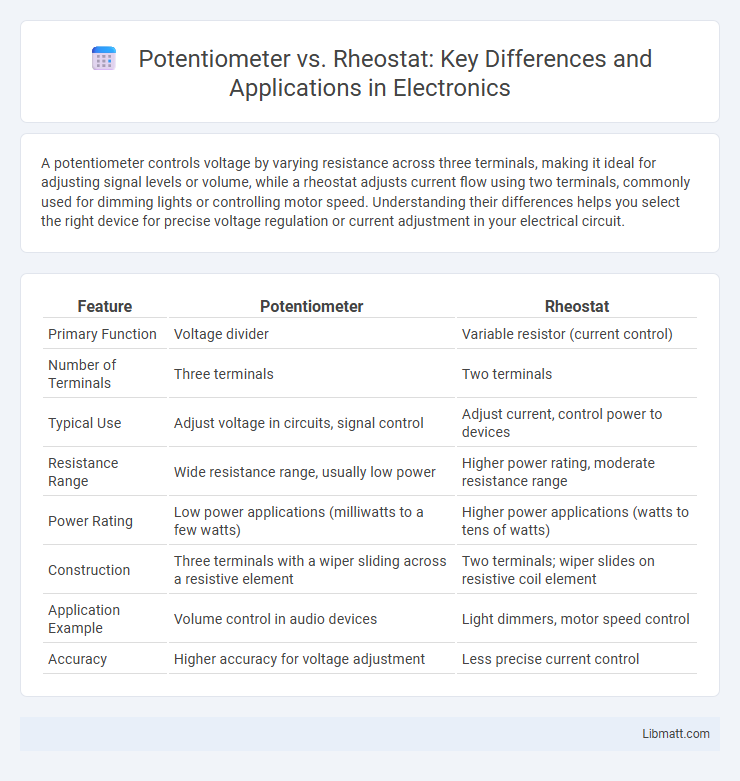A potentiometer controls voltage by varying resistance across three terminals, making it ideal for adjusting signal levels or volume, while a rheostat adjusts current flow using two terminals, commonly used for dimming lights or controlling motor speed. Understanding their differences helps you select the right device for precise voltage regulation or current adjustment in your electrical circuit.
Table of Comparison
| Feature | Potentiometer | Rheostat |
|---|---|---|
| Primary Function | Voltage divider | Variable resistor (current control) |
| Number of Terminals | Three terminals | Two terminals |
| Typical Use | Adjust voltage in circuits, signal control | Adjust current, control power to devices |
| Resistance Range | Wide resistance range, usually low power | Higher power rating, moderate resistance range |
| Power Rating | Low power applications (milliwatts to a few watts) | Higher power applications (watts to tens of watts) |
| Construction | Three terminals with a wiper sliding across a resistive element | Two terminals; wiper slides on resistive coil element |
| Application Example | Volume control in audio devices | Light dimmers, motor speed control |
| Accuracy | Higher accuracy for voltage adjustment | Less precise current control |
Introduction to Potentiometers and Rheostats
Potentiometers and rheostats are variable resistors used to control electrical resistance in circuits, with potentiometers primarily designed for voltage division and rheostats for current regulation. Potentiometers feature three terminals and are commonly employed in applications such as volume control, while rheostats typically have two terminals and are used to adjust current flow in devices like dimmer switches. Understanding the distinctions between your potentiometer and rheostat options is crucial for selecting the appropriate component for precise electrical control.
Key Differences Between Potentiometers and Rheostats
Potentiometers primarily function as voltage dividers with three terminals, allowing precise adjustment of output voltage, while rheostats are two-terminal variable resistors designed to control current flow in a circuit. Rheostats typically handle higher power and currents, making them suitable for applications like dimming lights or adjusting motor speeds, whereas potentiometers are used for signal-level adjustments such as tuning audio equipment. Understanding these key differences helps you select the right component for accurate voltage control or current regulation in your electronic projects.
Basic Working Principle of Potentiometers
Potentiometers operate by varying the resistance through a sliding contact that moves along a resistive element, allowing precise control of voltage output. You can adjust the voltage division ratio, which makes potentiometers ideal for tuning circuits and controlling signal levels. Unlike rheostats that primarily handle current adjustment, potentiometers provide fine-tuned voltage control in applications such as volume knobs and sensor calibration.
Basic Working Principle of Rheostats
Rheostats operate by varying the resistance in an electrical circuit through a sliding contact that moves along a resistive wire or track, changing the length of the resistor in use. This adjustment controls current flow without interrupting the circuit, making rheostats ideal for fine-tuning current and voltage in devices like dimmer switches and motor speed controls. Unlike potentiometers that function as voltage dividers, rheostats primarily modulate current by altering circuit resistance.
Common Applications of Potentiometers
Potentiometers are commonly used in volume controls for audio equipment, light dimmers, and as position sensors in joysticks and various industrial controls. They provide precise adjustable resistance, allowing for fine-tuned control of electrical devices. You can rely on potentiometers for applications requiring variable voltage output and user-adjustable settings.
Common Uses of Rheostats
Rheostats are commonly used in applications requiring adjustable current control, such as dimming lights, regulating motor speed, and managing heating elements. Their ability to handle high power makes them ideal for heavy-duty electrical circuits and experimental setups in laboratories. Rheostats are also frequently employed in audio equipment for volume control and in various industrial machinery for fine-tuning electrical resistance.
Construction and Design Comparison
A potentiometer consists of a three-terminal design with a resistive element and a sliding contact (wiper) that adjusts voltage output, while a rheostat typically features two terminals used to control current by varying resistance. You will find potentiometers often have a rotary or linear form factor for precise voltage regulation, whereas rheostats are usually bulkier with a coil resistive wire for handling higher power loads. Both devices use resistive materials like carbon or metal film, but their structural differences impact their application in electronic circuits.
Advantages and Disadvantages of Potentiometers
Potentiometers offer precise voltage control, making them ideal for tuning and calibration in electronic circuits, with advantages including smooth adjustment and low power consumption. However, their disadvantages include limited current handling capacity and potential wear over time due to mechanical movement, which can affect reliability. Unlike rheostats, potentiometers primarily function as voltage dividers rather than variable resistors, restricting their use in high-current applications.
Pros and Cons of Rheostats
Rheostats offer precise control of current by varying resistance, making them ideal for applications requiring adjustable power levels, such as dimming lights and controlling motor speed. Their simplicity and ability to handle high power loads provide reliability and durability in harsh environments. However, rheostats can generate significant heat and are less energy-efficient compared to modern electronic controls, which may affect your device's overall performance and longevity.
Choosing Between Potentiometer and Rheostat
Choosing between a potentiometer and a rheostat depends on your specific application requirements: potentiometers are ideal for precise voltage control and adjustable voltage division in circuits, providing three terminals for fine-tuning output voltage. Rheostats, featuring two terminals, are better suited for adjusting current in high-power settings like motor speed control or light dimming. Understanding whether you need voltage adjustment or current regulation in your design will guide your choice for optimal performance.
Potentiometer vs Rheostat Infographic

 libmatt.com
libmatt.com